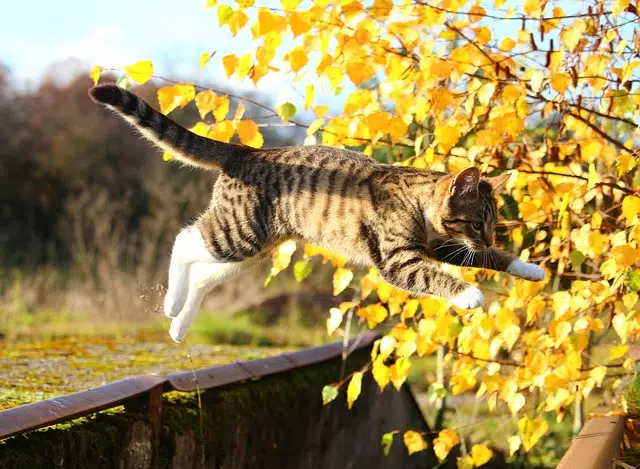Home » Blog » Pet » Pets: Understanding Them » Do Cats Always Land On Their Feet?
Categories
Tags
animal welfare
breed profile
buying a car
buying a pet
Car
car accessories
car care
car features
car insurance
Car safety
car sales
car service
cat
cat behaviour
cat body language
Cat Breeds
cat food
cat insurance
comprehensive car insurance
Dog
Dog Behaviour
dog body language
Dog Breeds
dog food
Dog Insurance
dog training
eco friendly cars
Kitten
New Car
pet accessories
pet activities
Pet Adoption
pet breeders
pet days of the year
pet fun stuff
Pet Health
pet insurance
pet parenting
Pet Safety
pet services
Puppy
rescue pets
road safety
road trip
safe driving
Recent Blog:
Facebook Posts
1 week ago
Ready for a fun challenge? 🐾 Take a wild guess: What breed is this adorable fellow? 🐶 Drop your answers in the comments, and don't forget to scroll down to check if you nailed it! 🎯 Let's see who knows their dog bree#dogbreedquizgBreedQuiz![]() .
.![]() .
.![]() .
.![]() .
.![]() .
.![]() .
.![]() .
.![]() .
.![]() .
.![]() .
.![]() .
.![]() .
.![]() .
.![]() .
.![]() .
.![]() Lagotto Romagnolo
... See MoreSee Less
Lagotto Romagnolo
... See MoreSee Less
1 week ago
Did you know heart disease in dogs and cats can start with bad oral health? Find out more.....
... See MoreSee Less
Why Pet Dental Health is Linked to Heart Disease and Other Illness
bit.ly
Pet dental health usually brings to mind images of teeth and gums. In reality, it goes far beyond that. Pet oral health can be directly linked to systemic2 weeks ago
Yes or No - got any road adventures planned for Easter? Whatever you answered, here are some great ideas for this year (or next):![]() #easter.
... See MoreSee Less
#easter.
... See MoreSee Less
Driving, Flying and Staycations with Dogs and Cats this Easter
bit.ly
Is cat or dog friendly Easter travel on your wishlist? You're one of many! Travelling with dogs, cats and even some other critters (think bearded dragonsIs it true that cats always land on their feet? It might sound like an old wives tale or just a figure of speech but in fact, cats do almost always land on their feet. Maybe not every single time, but most of the time.
And here are us humans, falling over our own feet and landing face first. So why have cats won the evolution lottery when it comes to always landing on their feet? Even when gravity and science are against them?
We’re got the answers!
Why do cats always land on their feet?
The reason for why (or how) cats always land on their feet has perplexed us humans for years. And there’s a reason for that. Basically, what cats do in order to land upright can’t be seen by the human eye. And even if it could be seen, you’d be a bit preoccupied with hoping the cat was ok to watch the fall too closely.
But evidently, this mysterious feline super power has been the subject of discussion for quite some time. Because way back in 1894, French scientist Étienne-Jules Marey created a special camera which could see what exactly cats were doing mid-fall.
Marey’s camera took twelve separate images in just one second. When you watch the video below, you’ll notice that the cat looks almost like a gymnast mid-tumble. And they’re pretty good at always landing on their feet too.
Watch this video to see what Marey’s camera captured:
How the spine helps cats always land on their feet
Basically, both gymnasts and cats are really flexible. Cats have a super flexible spine that can swivel and move in two parts. Almost like they have two separate spines! It’s this which allows cats to always land on their feet when they fall. Or most of the time, anyway.
We don’t want to get too science-heavy here, but this swivelling action means cats can exert a force on themselves. Newton’s first law of motion says a falling object can’t change its position without another force exerted on it. But because the cat’s spine is able to act like two separate entities, a cat can exert its own force on itself.
So it’s true, they really are a law unto themselves. But seriously, cats are out here defying the laws of physics in order to land on their feet. Amazing, when you think about it. Take that, dog lovers!
Oh, and if you want to read up on another cat phenomenon rooted in science, you’re in luck. Read are all ginger cats male? to find out whether ginger Toms are sometimes ginger Tiffanys.
Cat righting reflex
Cats intuitively know up from down, even when they’re falling. This ability to right themselves and land on their feet is called the cat’s righting reflex. It’s developed really early, when they’re around three or four weeks old.
It’s all thanks to their flexible backbone combined with their collarbones. Unlike humans, a cat’s collarbones aren’t attached to the bones around them. So that’s another tick for ridiculous flexibility.
You’ve probably heard that cats use their tails to help them right themselves when they fall. But in reality, even cats without tails have this righting reflex. And it isn’t limited to domestic cats either. Even big cats like lions and leopard have it.
Just check out this video of a leopard and lion both falling out of a tree. It just goes to show that even wild cats always land on their feet!
And for those odd occasions where a cat doesn’t land on their feet, a pet insurance plan can help you cover the bills. So they can get back on their feet again, without you worrying about the costs.
So……………..
Share On:




